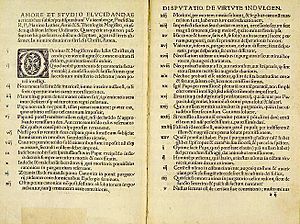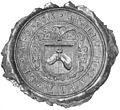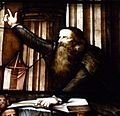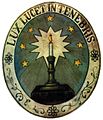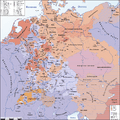Protestant Reformation facts for kids
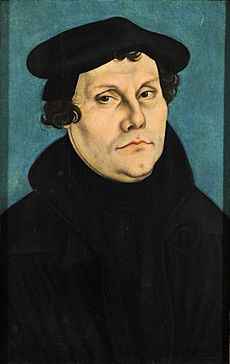
The Protestant Reformation was a big series of changes that happened in the 16th century. It affected the Christian Church in Europe. At this time, many people felt that the Catholic Church had become corrupt. They believed it needed to change its ways.
Important thinkers like Martin Luther, John Calvin, Huldrych Zwingli, and Erasmus spoke out. They wanted to fix the problems they saw. This led to a huge split in the church. It divided Christians into Catholics and many different Protestant churches. This split also caused the Catholic Church to start its own changes, known as the Counter-Reformation.
Many people see Martin Luther's actions in 1517 as the start of the Protestant Reformation. He posted his "Ninety-Five Theses" in Wittenberg, Germany. These were ideas he wanted to discuss about the church. Luther's ideas spread quickly, partly because of the new printing press. This invention helped share his thoughts and the problems with the church far and wide.
As different countries adopted Protestant ideas, serious wars broke out. These conflicts were between Catholic and Protestant groups and nations. Many people died in wars like the Thirty Years' War and the Eighty Years' War. These wars weren't just about religion. Since most countries had an official state religion, many fights were also about politics and power. The Peace of Westphalia in 1648 finally brought an end to many of these wars. It recognized Protestants and allowed countries to choose their own religion without outside interference.
The printing press was very important. It helped people learn about the problems in the Church. It also helped translate the Bible into many local languages. Before this, the Bible was mostly in Latin. People like John Wycliffe and William Tyndale worked to translate it into English. Luther himself translated the Bible into German. This meant ordinary people could read the Bible for themselves.
Contents
What Caused the Reformation?
At the start of the 16th century, several things led to the Protestant Reformation. Many people began to criticize the Catholic Church. They saw problems with some of its leaders, known as the Clergy.
Problems with Church Leaders
The greed and bad behavior of some church leaders created a gap between them and ordinary people. Often, these leaders did not speak the local language. They also sometimes did not live in their own church areas. This meant they often didn't understand or respond to what the people needed. Over time, the papacy (the Pope's authority) also lost some respect.
However, the main reasons for the split were more about what the church taught than just corruption. Here are some of the key issues:
- The Bible was mostly printed only in Latin. Most people did not understand Latin. The church also controlled printing through a system called censorship. The main church service, Catholic Mass, was also in Latin. This meant people could not easily check if what the priest said was truly from the Bible.
- The church sold special "tickets" called indulgences. These tickets were supposed to offer forgiveness from sins for money. This made it seem like rich people could buy their way into Heaven. This was very different from what the Bible taught, which says that salvation is a gift, not something you buy.
- Important church jobs were often sold to the person who paid the most money. This practice was called Simony. Because of this, many priests did not know much about Christianity. They sometimes taught things that were not in the Bible.
Martin Luther's Protest
In 1515, the Pope started a new campaign to sell indulgences. The money was meant to help rebuild St. Peter's Basilica, a large church in Rome. Preachers came to Germany to sell these indulgences. They promised that buying them could even free souls from purgatory (a place where souls are purified after death).
Martin Luther, a German Catholic monk, felt this was wrong. On October 31, 1517, he sent his 95 theses to the local archbishop. These were 95 points he wanted to debate. It is also said he nailed a copy to the door of a church in Wittenberg. Most of his points were about the problems with selling indulgences.
Luther argued that buying forgiveness prevented people from truly turning away from their sins. He also said it made people give less money to the poor. At first, Luther did not directly attack the Pope. He blamed others for the abuses. But his ideas suggested that the Pope might also be involved in the corruption.
Without Luther's permission, his 95 Theses were translated into German. They were then sent to many places, and many people agreed with him. The Catholic Church tried to stop these new ideas, but it was difficult. Luther was seen as an enemy of the Pope. When he refused to change his ideas, he was excommunicated (removed from the church). In the beginning, Luther did not plan to leave the Catholic Church. He only wanted to fix its problems.
What Happened Next?
In many countries, Christians started to put Luther's ideas into practice. People began to read the Bible in their own language. Many could then see for themselves how the Catholic Church had changed some Christian teachings. Even some who stayed Catholic adopted parts of Luther's ideas.
Catholic Church's Response
The Pope brought back the Inquisition. This was a church court that tried to stop heresy (ideas against church teachings). The Catholic Church responded to the Protestant Reformation with its own changes, called the Counter-Reformation. Between 1545 and 1563, the Council of Trent met to decide what to do. Some of the worst problems were fixed, but many old teachings were kept. The Inquisition tried to make people follow these ideas.
When force wasn't enough, the Pope created new religious orders. One important group was the Jesuits. These new orders were told to fight Protestantism by educating people about Catholicism. The Pope also made the Index Librorum Prohibitorum, a list of banned books. This list had a big impact for centuries and was only ended in the 1960s. The Catholic Church also used baroque art to inspire strong religious feelings and bring people back to the Catholic faith.
Political Changes
Besides changes in the churches, there were also political results. Ordinary people became more willing to question their leaders. In 1524-1525, millions of peasants rebelled against nobles. They did this in the name of human equality before God. Many European countries chose Protestantism as their official state religion. This divided Europe by religion. This led to religious wars, like the French Wars of Religion.
For a short time, Protestants and Catholics managed to live together. The Peace of Augsburg in 1555 recognized the religious division of the German states. It gave Protestants the right to practice their religion.
Long-Term Effects
For a long time, Catholic countries like Spain and Italy did not allow Protestants to live there. And Protestant countries often kept out Catholics. But with the American Revolution, the idea of freedom of religion began to spread.
Protestants became very important in the United States and English Canada. Quebec was a Catholic province that used to belong to France. After the Seven Years' War, the British passed the Quebec Act. This law gave freedom of religion in Quebec. It also included parts of what is now the United States, like Ohio and Michigan. Catholics were given religious freedom in these areas. Protestant colonists saw this as one of the "Intolerable Acts." In later centuries, many Protestant churches were started in Quebec. Many Catholic churches also began in Ohio and Michigan. Eventually, most Christian countries allowed some religious freedom.
Churches based on the Reformation ideas have grown and changed into many different forms. This is especially true in countries that were historically Protestant. Even in much of Latin America, which is mostly Catholic, Evangelical churches have grown a lot. These churches follow many Protestant ideas.
In the 20th century, some countries still had official state churches. But they also allowed full freedom of religion. In these countries, conflicts between Protestant and Catholic Christians became less important. They often had to work together to face a more secular (less religious) society. In 2016, Pope Francis even praised Luther during a prayer service. This service marked 500 years since the Reformation began. Some Protestant churches have also started to use some Catholic worship traditions. Others have praised Catholics for their stance on social issues.
Related pages
Images for kids
-
Martin Luther at the Diet of Worms, where he refused to change his mind when asked by Charles V.
-
Martin Luther's 1534 Bible translated into German. This translation helped shape the German language.
-
Erasmus was a Catholic priest who inspired some of the Protestant reformers.
-
Jiří Třanovský (1592–1637), known as the "Luther of the Slavs." He was active in Bohemia, Moravia, Poland, and Slovakia.
-
Huldrych Zwingli started the Reformation in Switzerland.
-
John Calvin was a key leader of the Reformation. His ideas still influence many churches today.
-
Henry VIII broke England's ties with the Roman Catholic Church. He became the head of the English Church.
-
Thomas Cranmer was very important in the English Reformation.
-
Oliver Cromwell was a strong Puritan and military leader. He became Lord Protector of England, Scotland, and Ireland.
-
John Knox was a leading figure in the Scottish Reformation.
-
Even though he was a Catholic clergyman, Cardinal Richelieu allied France with Protestant states.
-
A drawing from the time showing the public punishment of fourteen Protestants in Valladolid, Spain, on May 21, 1559. They were burned for their faith.
-
Stephen Bocskai stopped the Holy Roman Emperor from forcing Catholicism on Hungarians.
-
A devout Catholic, Mary I of England started the first Plantations of Ireland. These later became associated with Protestantism.
-
Jan Łaski worked for unity among different Christian Churches and took part in the English Reformation.
-
Primož Trubar, a Lutheran reformer in Slovenia.
-
Religious divisions in Central Europe at the start of the Thirty Years' War (1618).
-
The Peace of Westphalia allowed Calvinism to be practiced freely.
-
Katharina von Bora helped shape social ideas during the Reformation.
See also
 In Spanish: Reforma protestante para niños
In Spanish: Reforma protestante para niños


